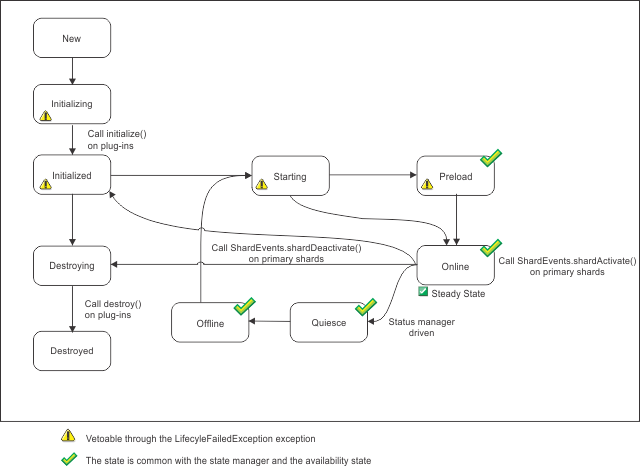ObjectGridLifecycleListener plug-in
An ObjectGridLifecycleListener plug-in receives notification of WebSphere® eXtreme Scale life cycle, state change events for the data grid.
Overview
An ObjectGridLifecycleListener plug-in is useful when an existing ObjectGrid plug-in needs to perform activities relative to activities in a related plug-in. As an example, a TransactionCallback plug-in might need to retrieve the configuration from a cooperating ObjectGridEventListener or ShardListener plug-in.
By implementing the ObjectGridLifecycleListener interface, and detecting the ObjectGridLifecycleListener.State.INITIALIZED event, the TransactionCallback plug-in can detect the state of other plug-ins in the ObjectGrid instance. The TransactionCallback plug-in can safely retrieve information from the cooperating ObjectGridEventListener plug-in or ShardListener plug-in, since the ObjectGrid is in the INITIALIZED state, which means that the other plug-in has had its initialize() method called.
You can add an ObjectGridLifecycleListener plug-in at any time, either before or after the ObjectGrid is initialized.
Write an ObjectGridLifecycleListener plug-in
An ObjectGridLifecycleListener plug-in must implement the ObjectGridLifecycleListener interface to receive notifications about significant eXtreme Scale events. Any ObjectGrid plug-in can implement the ObjectGridLifecycleListener interface and be automatically added as a listener when it is also added to the ObjectGrid.
For more information about these interfaces, see the API documentation.
Life cycle event and plug-in relationships
public void objectGridStateChanged(ObjectGrid grid,
LifecycleEvent event)
throws LifecycleFailedException {
switch(event.getState()) {
case INITIALIZED: // All other plug-ins are initialized.
// Retrieve reference to plug-in X for use from grid.
break;
case DESTROYING: // Destroy phase is starting
// Eliminate reference to plug-in X it may be destroyed before this plug-in
break;
}The following illustration summarizes the states of the ObjectGrid objects as life cycle events occur and are sent to a ObjectGridLifecycleListener plug-in.

The following table further describes the relationship between life cycle events sent to a ObjectGridLifecycleListener and the states of the ObjectGrid and other plug-in objects.
| ObjectGridLifecycleListener.State value | Description |
|---|---|
| INITIALIZING | The ObjectGrid initialization phase is starting. The ObjectGrid and ObjectGrid plug-ins are about to be initialized. |
| INITIALIZED | The ObjectGrid initialization phase is complete. All ObjectGrid plug-ins are initialized. The INITIALIZED state might recur when shard placement activities (promotion or demotion) occur. All BackingMap plug-ins in the BackingMap instances owned by this ObjectGrid instance have been initialized. |
| STARTING | The ObjectGrid instance is being activated for use as a local instance, client instance, or as an instance in a primary or replica shard on the server. The STARTING state might recur when shard placement activities (promotion or demotion) occur. |
| PRELOAD | The ObjectGrid instance is set to the PRELOAD state by the StateManager API or other configuration. |
| ONLINE | The ObjectGrid instance is ready for work as a local instance, client instance, or as an instance in a primary or replica shard on the server. This steady state is typical of the ObjectGrid. The ONLINE state might recur when shard placement activities (promotion or demotion) occur. |
| QUIESCE | Work is stopping on the ObjectGrid as a result of the StateManager API or other event. No new work is allowed. End any existing work as soon as possible. |
| OFFLINE | All work is stopped on the ObjectGrid as a result of the StateManager API or other event. No new work is allowed. |
| DESTROYING | The ObjectGrid instance is starting the destroy phase. ObjectGrid plug-ins for the instance are about to be destroyed. During the destroy phase, all BackingMap instances owned by this ObjectGrid instance are also destroyed. |
| DESTROYED | The ObjectGrid instance, its BackingMap instances, and all ObjectGrid plug-ins have been destroyed. |
Configure an ObjectGridLifecycleListener plug-in with XML
Assume that the class name of the eXtreme Scale event listener is the com.company.org.MyObjectGridLifecycleListener class. This class implements the ObjectGridLifecycleListener interface.
<?xml version="1.0" encoding="UTF-8"?>
<objectGridConfig xmlns:xsi="http://www.w3.org/2001/XMLSchema-instance"
xsi:schemaLocation="http://ibm.com/ws/objectgrid/config ../objectGrid.xsd"
xmlns="http://ibm.com/ws/objectgrid/config">
<objectGrids>
<objectGrid name="myGrid">
<bean id="ObjectGridLifecycleListener"
className="com.company.org.MyObjectGridLifecycleListener" />
<backingMap name="Book"/>
</objectGrid>
</objectGrids>
</objectGridConfig>Notice the bean declarations come before the backingMap declarations. Provide this file to the ObjectGridManager plug-in to facilitate the creation of this configuration.
Like the registered ObjectGridLifecycleListener in the previous example, other ObjectGrid plug-ins, CollisionArbiter or TransactionCallback for example, that you specify using XML that also implement the ObjectGridLifecycleListener interface, will automatically be added as life cycle listeners.